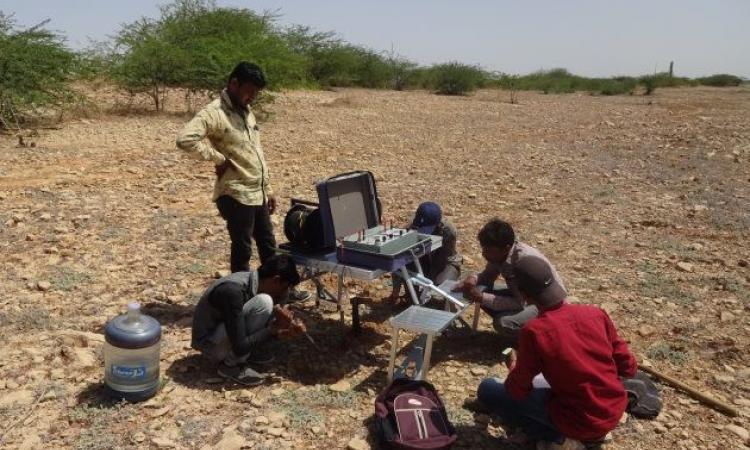
The word Kachch is derived from the Gujarati word ‘Kachha’, meaning tortoise, from which the drought-prone district of Kutch gets its name. The topography of this place is such that it gets the highest elevation in the centre. The central highland, called the Bhuj ridge, is the source of groundwater resources and rivers. The rivers in the Kutch region are non-perennial and have a high runoff. Whatever little rains fall on this region quickly gets washed away in streams and then into the sea. The erratic rainfall and high runoff make water a sparse resource.
The development of industries and power plants near the area has added more complexities to the problem. Irrigation demand in the Kutch region is dependent on groundwater, and over-extraction of the groundwater has threatened water security. The state revenue department in 2018 declared that condition in five out of 10 talukas in Kutch had been assessed as ‘severe’.
The prevailing problem of groundwater extraction and over-exploitation was brought into focus by the local organisation Arid Communities and Technologies. They tried to address the issue through the involvement of the community by Participatory Groundwater Management (PGWM) approach. PGWM has emerged as an alternative way for managing groundwater as a common pool resource.
Around 10-15 years ago, the village depended on dug wells for drinking purposes, and farming was mainly rainfed with a few exceptions. After the intervention of the borewell technology, agriculture shifted to irrigated farming. Due to excessive over-extraction of groundwater, the village has witnessed a shift in cropping patterns. Farmers have shifted from high water-intensive crops like cotton, groundnut, castor, mango, banana to lower water-intensive crops like date palm, Bt cotton, and fodder crops. However, some farmers were growing sugarcane because the sugar mill near the village provides a good price to farmers and is readily accessible.

The absence of surface water and erratic rainfall has raised the alarm, and the farmers in the village have realised the importance of groundwater. To conserve the water, they have started adopting drip irrigation practices. The usage of drip irrigation is confined to few crops like cotton, groundnut, castor and some horticulture crops except date palm. Only a handful of large farmers have installed drip irrigation systems in every plot. However, none of the farmers, including large farmers have shifted to sprinkler systems as high total dissolved solids in water may damage the machine equipment due to salt deposition.
To conserve the groundwater, villagers of Moti Khakar came forward and formed a group of 15-20 members who started constructing recharge structures. The group is also spreading awareness about recharge and its potential benefits. The group bears the recharge construction cost, and the beneficiary charges only a minimal amount to give them a sense of ownership. The group is performing the recharge in every bore and dug well, irrespective of their area of influence.
They directly let the water down without using any filter, potentially choking up the structure in the future. In the coming years, the well or borewell might lose its ability to recharge water. The method of recharge adopted by the community is completely different from that of ACT.
ACT selects volunteers in the village called ‘Bhujal Jankars’ (Barefoot Groundwater Scientists) with the purpose of building a sense of ownership among the community. The Bhujal Jankar is trained in relevant aspects such as mapping, water table and water quality measurement, and some basic hydrological concepts affecting groundwater availability and agricultural uses.
Bhujal Jankar conducted a baseline survey with the help of the project team of ACT to compile the necessary information about the village wells, tube wells, and ponds at Moti Khakar. The Bhujal Jankar closely monitors on a weekly basis the groundwater level depths and on a monthly basis the changes in groundwater through pH, Total Dissolved Solids (TDS), and Electrical Conductivity.
There is a significant knowledge gap about recharge structure and methods between the local recharge and ACT organisations. Although the local recharge group makes the best efforts to manage and recharge the groundwater, they often lack the skills and context-specific tools required for such management. The local recharge group in Moti Khakar village can improve their competencies through proper capacity-building workshops or training.
To move ahead with the recharge campaign, formalisation of the local recharge group is a prerequisite. Then only more and more farmers will join the group officially. This will also lead to better operation and maintenance of the recharge structures. Villagers will be accountable to these formal local groups. Most members will be farmers, and the group can forbid the farmers to go back to water-intensive crop cultivation. During the study, few farmers claimed they would grow water-intensive crops if the groundwater situation improves as market prices are high.
To successfully implement PGWM, there is a need to understand groundwater science from a community perspective. For this to happen, there is a need for ardent individuals from the community, who are willing to understand the science and social aspects behind it to use the skill for the upliftment of their community.
The study was conducted in October 2019 with the Centre of Water Policy and Governance, Tata Institute of Social Sciences, Mumbai and Arid Communities and Technology, Bhuj, Gujarat.